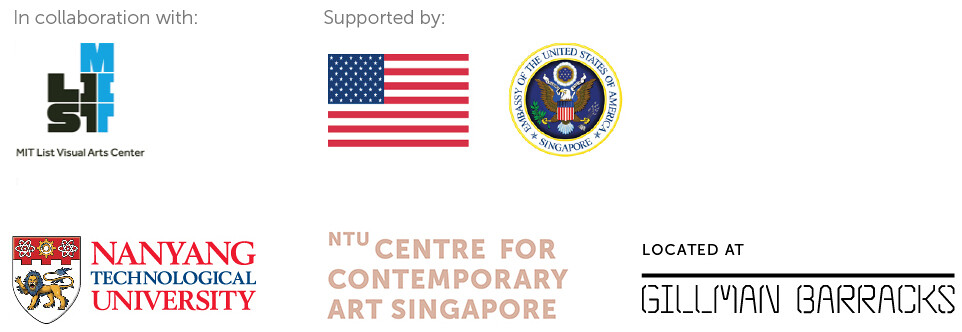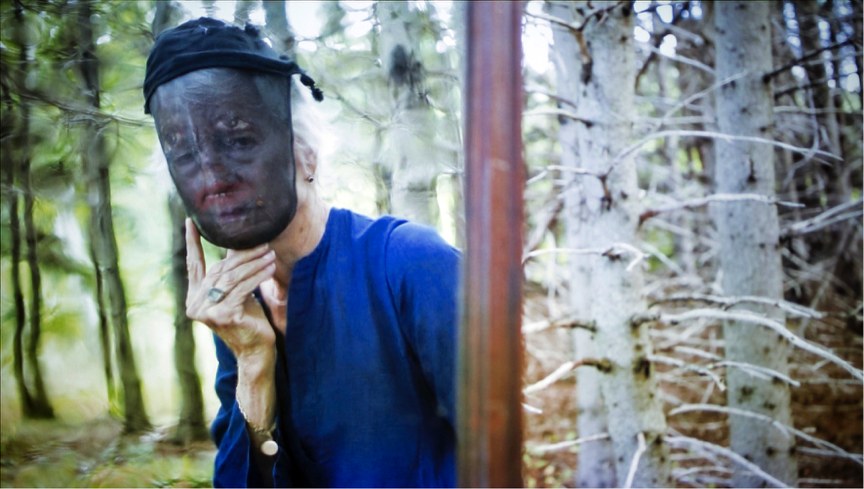They Come to Us without a Word
January 22–April 3, 2016
Gillman Barracks
Block 6 Lock Road #01-09
Singapore 108934
Hours: Tuesday–Sunday 12–7pm
T +65 6334 7948
ntuccacomms@ntu.edu.sg
The NTU Centre for Contemporary Art Singapore (NTU CCA Singapore) is delighted to collaborate with the MIT List Visual Arts Center and honoured to present They Come to Us without a Word, the discipline-defining video and performance pioneer Joan Jonas’ first major exhibition in Singapore and Southeast Asia. Presented and commissioned for the US Pavilion by the MIT List Visual Arts Center at the 56th Venice Biennale, They Come to Us without a Word is co-curated by Paul C. Ha and Ute Meta Bauer. Awarded a prestigious “Special Mention” by the International Jury of the Biennale, They Come to Us without a Word evokes the fragility of nature in a rapidly changing environment. In her own poetic language, Jonas addresses the irreversible impact of human interference on the environmental equilibrium of our planet.
They Come to Us without a Word evolved out of an earlier work, Reanimation, inspired by the writings of Icelandic author Halldór Laxness and his poetic portrayal of the natural world. Each room of Jonas’ installation represents a particular creature (bees, fish), object (mirror), force (wind), or place (the homeroom). Fragments of ghost stories sourced from an oral tradition in Cape Breton, Nova Scotia, form a nonlinear narrative linking one room of Jonas’ installation to the next. In a mirrored room full of reflections, crystal beads strung on a chandelier-like structure lie suspended from the middle of the ceiling, creating shadows that move all over the walls. These spoken fragments function partly as a reference to what remains, “Ghosts are very much alive there, as in all parts of the world,” Jonas explains. “We are haunted, the rooms are haunted.”
NTU CCA Singapore first presented Jonas’ work Lines in the Sand during the exhibition Theatrical Fields in 2014, a multimedia installation of emblematic imagery and objects blurring the lines between myth and reality. They Come to Us without a Word at NTU CCA Singapore introduces a larger and more comprehensive body of Jonas’ work, highlighting the key themes of her work that draw from narratives of ghost stories, extinction of nature, and shadows which resonate with Southeast Asia’s preoccupation with the supernatural.
A study room and extensive public programme for They Come to Us without a Word consisting of film screenings, workshops and Exhibition (de)Tours will allow a deeper engagement with Jonas’ pioneering artistic practice that connects with the strong tradition in Singapore of performance art and experimentation with theatricality and time-based media. Various contributors to the public programme include: artist and award-winning filmmaker Park Chan-kyong, academics Kenneth Dean and Mark Nash, and lighting designer Jan Kroeze, who conceived the customised lighting for the installation and has collaborated with cultural figures Merce Cunningham and Laurie Anderson.
Jonas’ interdisciplinary approach towards her practice continues to be crucial to the development of many contemporary art genres, from performance and video, to conceptual art and theatre. “Joan’s voice and vision have been powerful forces in contemporary art for five decades,” says Paul C. Ha, commissioner and co-curator of the 2015 US Pavilion, elaborating that her selection to represent the US Pavilion at the Biennale is an acknowledgement of her outstanding contributions to the art world.
She was one of the first artists to explore the potential of the video camera as a tool for image-making and the TV monitor as a sculptural object. This led her to experiment and develop a distinct visual language exploring how the image is altered through the mediums of mirror, distance, video, and narrative. “As I know from working with Joan as both a curator and educator, one does not only see her work, one experiences it,” says Ute Meta Bauer of Jonas’ ability to work with spaces, transforming them into profound encounters.
Programme
In conversation
January 15, 7:30–9pm
with Joan Jonas, Ute Meta Bauer, Founding Director, NTU CCA Singapore and Anna Daneri, NTU CCA Singapore Curator-in-Residence, curator and Founding Co-Director of Peep-Hole
Behind the Scenes
January 19, 1–3pm
with Jan Kroeze, lighting designer
Curatorial tour
January 23, 11am–1pm
with Anna Daneri
Workshop for teachers & educators
January 30, 10am–12pm
with Kelly Reedy, artist and educator
Exhibition (de)Tour
February 10, 7:30–9pm
with Filipa Ramos, NTU CCA Singapore Curator-in-Residence and curator
Screening
February 12, 7:30–10pm
Selected films by Park Chan-kyong, artist and filmmaker & Park Chan-wook, filmmaker
Workshop and screening
February 13, 1–4pm
Selected films by Park Chan-kyong
Exhibition (de)Tour
February 17, 7:30–10pm
with Yasser Mattar, behavioural scientist and paranormalist
Screening
February 26, 7:30–9pm
More than Honey by Markus Imhoof, artist and filmmaker
Exhibition (de)Tour
March 2, 7:30–9pm
with John Ascher, Assistant Professor, Department of Biological Science, NUS
Workshop and screening
March 18, 7:30–10pm
Selected films by Mark Nash, curator, writer, Visiting Associate Professor at NTU CCA Singapore and NTU ADM
Workshop and screening
March 19, 1–4pm
by Mark Nash
Exhibition (de)Tour
March 30, 7:30–9pm
with Kenneth Dean, Head of Chinese Studies Department, NUS
Acknowledgements
They Come to Us without a Word was organised for the US Pavilion of the 56th Venice Biennale by the MIT List Visual Arts Center and co-curated by Paul C. Ha, Director of the MIT List Visual Arts Center and Ute Meta Bauer, Founding Director of the NTU Centre for Contemporary Art Singapore. The exhibition was generously supported by US Department of State, Cynthia and John Reed, the Helen Frankenthaler Foundation, and the Massachusetts Institute of Technology. Additional major support was provided by the Council for the Arts at MIT, Toby Devan Lewis, VIA Art Fund, Agnes Gund, Lambent Foundation.
The exhibition in Singapore is organised by the NTU Centre for Contemporary Art Singapore, Nanyang Technological University with support by the Economic Development Board, Singapore. Additional support has also been provided by the US Embassy Singapore.



